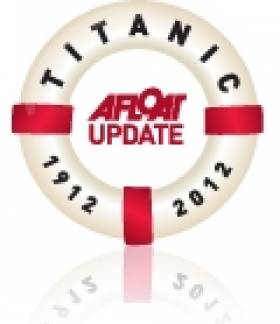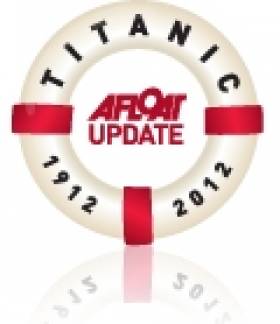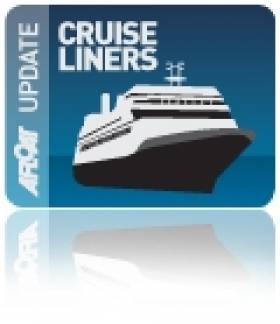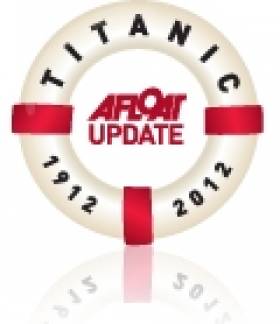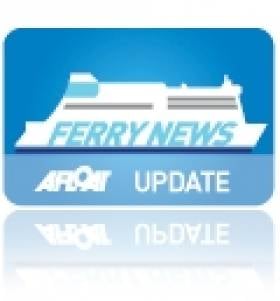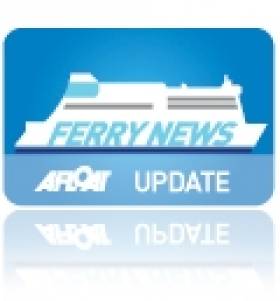Displaying items by tag: Harland & Wolff
H&W Headquarters and Drawing Offices to be Restored
#TitanicDrawingOffice- Northern Ireland's Alliance East Belfast MLA Judith Cochrane has welcomed the £5m grant from the UK's Heritage Lottery Fund programme that will restore the Harland & Wolff headquarters building and drawing offices in the Titanic Quarter.
Build.ie reports that the Grade B+ listed building will be turned into a boutique hotel which will create 109 jobs.
Judith Cochrane MLA said: "It is great news that a key part of our shipbuilding heritage will be restored with this grant. I hope this new hotel will become another place for tourists to see part of the Titanic's history.
"The new jobs created by this hotel will be a big boost to the local economy."
H&W Group Enjoy Successful Recovery
#BelfastLough – Belfast's Harland and Wolff Group (H&W) continues to operate as an expanding diverse engineering business.
The group has a number of special capabilities related to marine engineering and design, ship repair, and including offshore wind-farm fabrication. The company is a wholly owned subsidiary of the Norwegian Fred Olsen Energy Group.
In 2012, H&W enjoyed a significant increase in turnover and improved its profitability. This followed a loss in 2010 when trading conditions were described as 'externally challenging' and a recovery in 2011. For more on this story The Belfast Telegraph reports.
Birthday Bash as HMS Belfast Celebrates 75th Anniversary
#HMSBelfast – The Thames floating landmark, HMS Belfast celebrates its 75th anniversary, coinciding with this weekend's St. Patrick festivities held on both sides of the Irish Sea, writes Jehan Ashmore.
The Town-Class cruiser was launched on St. Patrick's Day 1938 from Harland & Wolff, Belfast. She is one of the last surviving WW2 warships remaining in UK waters. She was commissioned into the Royal Navy the following year and placed under the command of Captain G.A. Scott DSO.
During her career, HMS Belfast opened fire in support of Allied troops during the D-Day landing, was on escort duty during Artic convoys of merchant ships in addition to involvement in the Korean War.
To commemorate the historical significance of HMS Belfast, which has been moored on the Thames since 1971 as a major tourist attraction, a series of special events are to be held this weekend.
Her Belfast-based counterpart, the C-Class light cruiser HMS Caroline, which served in World War I having been built in 1914 at Cammell Laird, Birkenhead, lies on the Lagan.
As previously reported, the fate of the former Battle of Jutland survivor was secured following last year's decision to protect the vessel from falling into disrepair with a £1m restoration grant.
On completion of the work on the veteran vessel now in her 99th year, she is to become a major tourist attraction likewise of HMS Belfast.
'Titanic II' Plans Unveiled By Mining Millionaire
#Titanic - An Australian mining millionaire has unveiled his plans to resurrect the Titanic for the 21st century, as The Irish Times reports.
Clive Palmer wants to build a new version of the ill-fated cruise liner - to be dubbed Titanic II - recreating the style and comfort of the original, but with modern navigational instruments and enough lifeboats for all on board.
"Titanic was a ship of dreams and Titanic II promises to be the ship where dreams come true," he told reporters at the Ritz Hotel in London last week.
Already he claims that 40,000 people have enquired about passage, and 16 individuals have offered $1 million each for a state room on the new liner for its maiden voyage after the vessel is completed in late 2016.
Titanic II will not be an exact replica of its predecessor, as it's planned to be four metres wider to provide greater stability, as well as featuring stabilisers and reverse propellers to provide for a more comfortable voyage.
It will also not be built at Harland & Wolff, the Belfast Lough shipyards that constructed the original White Star Line vessel, instead being contracted to the world record-holding large ship facilities at Jiangsu in China.
The Irish Times has more on the story HERE.
Detained Cruiseship Departs Dublin Port After Fuel Bill Resolved
#CRUISESHIP RELEASED – As previously reported, the Princess Danae (1955/16,531grt) which was at the centre of a dispute over an unpaid fuel bill departed Dublin Port last night, after the High Court set aside orders it had earlier granted detaining the vessel.
Yesterday afternoon the High Court ordered the arrest and detention of the Madeira registered vessel which arrived in Dublin yesterday morning, having sailed through the North Channel.
The 800 passenger and crew capacity cruiseship, was detained arising out of an alleged failure by its owners to pay an outstanding fuel bill of $94,000 (€74,940).
All but three bunks aboard the ship were occupied at the time Princess Danae was detained. The vessel was built originally as the cargoship Port Melbourne by Harland & Wolff, Belfast and is currently en-route to La Rochelle in western France.
Ports & Shipping Review: Champagne Voyage, Cruiseship Safety, Scienceship, Ferry Sold, P&O 175th,Belfast Boost
#PORTS & SHIPPING REVIEW - Over the last fortnight Jehan Ashmore has reported from the shipping scene which saw the second WFSV Gardian 10 make a delivery 'Champagne 'promo-voyage to her UK East coast based owners.
Following the Costa Concordia incident, tighter inspections of vessels visiting our ports will be carried out according to the Marine Survey Office.
With all things scientific with the ESOF conference in Dublin, as part of Dublin City of Science 2012, there is still time to apply for the Marine Institute's training position for their research vessel operations.
The last ever passenger (incl. car-ferry) built by Harland & Wolff in 1981, the St. David for Sealink/British Rail departed on her long delivery voyage for new Indonesian owners. For most of her career she served as the Stena Caledonia on the North Channel routes until her recent sale and renaming to Portlink.
P&O Cruises Arcadia sailed into Dublin Bay following a spectacular gathering of her fleetmates in Solent waters to celebrate the 175th anniversary of the world famous shipping company. P&O can trace their origins with an Irish connection as the Dublin and London Steam Packet Co. chartered their paddle-steamer William Fawcett, the vessel being regarded as the first ship working for P&O.
Belfast Harbour revealed record traffic levels for the year 2010-2011 as outlined at the company's annual report. The port showed a 2% rise in profit before taxation to £17.8m and a 4% increase in turnover to £36.1m.
Also in the northern port, the new iconic waterfront landmark of the Belfast Titanic visitor attraction is a key contributory factor in drawing the cruiseship sector. A total of 41 cruise callers are scheduled in 2012 which is an increase to last year's 32 ships.
Tribute to 'Forgotten' Titanic Workers in Belfast
#TITANIC - A new plaque has been unveiled in Belfast to remember eight men who died during construction of the Titanic in the city more than 100 years ago.
As UTV News reports, NI First Minister Peter Robinson was on hand at the unveiling of the tribute on the wall outside the Harland & Wolff Welders Club on Dee Street in East Belfast.
The First Minister described the eight men as an integral part of the Titanic story.
"In an era when the phrase 'health and safety' did not even exist it was seen as an inevitability that lives would be lost during any major construction or engineering project.
"It is important the story is told of those who built what was the largest ship afloat at that time."
Construction of the ill-fated cruise liner began in Slipway No 3 at the Harland & Wolff shipyards in March 1909, more than two years before her launch.
The workers' tribute joins a new memorial in the grounds of Belfast City Hall that lists the names of all 1,512 passengers and crew who perished in the tragedy.
UTV News has more on the story HERE.
Belfast Bids Farewell as Last Harland & Wolff built Irish Sea ‘Sealink’ Ferry Sets Sail
#FERRY DEPARTS FOR INDONESIA – An end of an era was marked this afternoon with the departure of the last passenger ship (including 'Sealink' car-ferry) built by Harland & Wolff, when Portlink, slipped down Belfast Lough, for the last time, for new owners in South East Asia, writes Jehan Ashmore.
Since November the ferry then named Stena Caledonia was withdrwan from Stena Line's Belfast-Stranraer route following the opening of a new €80m ferry terminal at Loch Ryan Port close to Cairnryan. The new route is also operated by a pair of larger, newer 'Superfast' sisterships built in 2001, while the older ferry embarks on a career with PT ASDP Indonesia Ferry (Persero).
Originally Stena Caledonia started her career as the St. David, which was launched in 1981 as the final member of a quartet of 'Saint' class near sisterships for Sealink/ British Rail. With her sale to overseas owners, she was the last of the Saint class still operating in UK waters.
Before today's start of the delivery voyage which includes a port of call to Gibraltar, invariably to call for bunkers, the 31 year-old veteran vessel, had been berthed close to the H&W's Musgrave yard. The St. David became the last vessel launched from that particular yard at the Queens Island complex. Incidentally she would also become the last ever passenger ship built at H&W.
For over the last two decades Stena Caledonia has provided a sterling service operating on the North Channel, firstly from Larne-Stranraer when Sealink was taken over by Stena Line in 1990 and then the route switched several years later to the Belfast-Stranraer route.
While in her earlier career as St. David she operated on two routes she was purpose built for between Dun Laoghaire-Holyhead and Rosslare-Fishguard, though she rarely served on the St. Georges service.
Instead she was deployed mostly on the Dun Laoghaire-Holyhead route alongside St. Columba, where these vessels featured a stern-bridge. The stern-bridge in itself also reflected an end of an era in ferry design, this was to facilitate easier and safer access while navigating the tighter confines of the inner harbour of the Welsh port located on Holy Island.
In between her early and final years on the Irish Sea, St. David also ran on routes from Dover where Sealink /British Rail operated their 'Blue' Ribbon service to Calais maintained by two of her three sisters.
#STENA SALE SHIP- Irish Sea ferry stalwart Stena Caledonia (1981/12,619grt) has been sold to ASDP Ferry of Indonesia according to Ships Monthly. The vessel remains moored in Belfast awaiting her delivery voyage, which will be the longest ever she is to undertake in her career, writes Jehan Ashmore.
All Stena Line funnel and hull markings of the 31-year old vessel have been painted out and she has been renamed Portlink and re-registered in Jakarta, the capital of Indonesia.
Since late November she stood down following the switch of Scottish ferryport from Stranraer to Cairnryan, where a new £80m Loch Ryan Port ferry terminal is served by two newly introduced and luxuriously refurbished sisters Stena Superfast VII and Stena Superfast VIII. The pair built in Germany in 2001 have successfully been introduced on the new Belfast-Cairnryan route.
Initially the Stena Caledonia was laid-up in Belfast at Albert Quay though in recent months she shifted berths to the former Outfit Quay at Harland & Wolff, ironically this location being very close to the facilities Musgrave Yard, where she built as St. David for Sealink / British Rail.
She became the last vessel to be launched from that particular yard on Queens Island and historically she is significant in that she is the last passenger (including car-ferry) vessel to be built by H&W.
'Land of Giants' Spectacle at Titanic Belfast
#BELFAST LOUGH – The largest outdoor arts event ever seen in Northern Ireland is to take place tonight in Belfast at the iconic landmark venue of the £100m Titanic Belfast, writes Jehan Ashmore.
The spectacle is a combination of acrobatics, aerial dance, carnival, circus, music, multi-media and pyrotechnics. An audience of more than 20,000 people will be part of the 'Land of Giants' which takes its inspiration from 'giants' that are present in Northern Ireland's history, both ancient and modern.
Special focus will be given to four: Finn McCool, the giant who built the Giant's Causeway; Gulliver, whose giant features are outlined in the hills surrounding Belfast; Samson and Goliath, the two cranes that have dominated the Belfast skyline for the past 40 years; and the Titanic, together with her less famous sister ship, the Olympic.
This evening's event of theatre and performance is part of the Legacy Trust UK Community Celebrations and the London 2012 Festival, a 12 week UK-wide cultural celebration for the London 2012 Olympic and Paralympic Games.


























